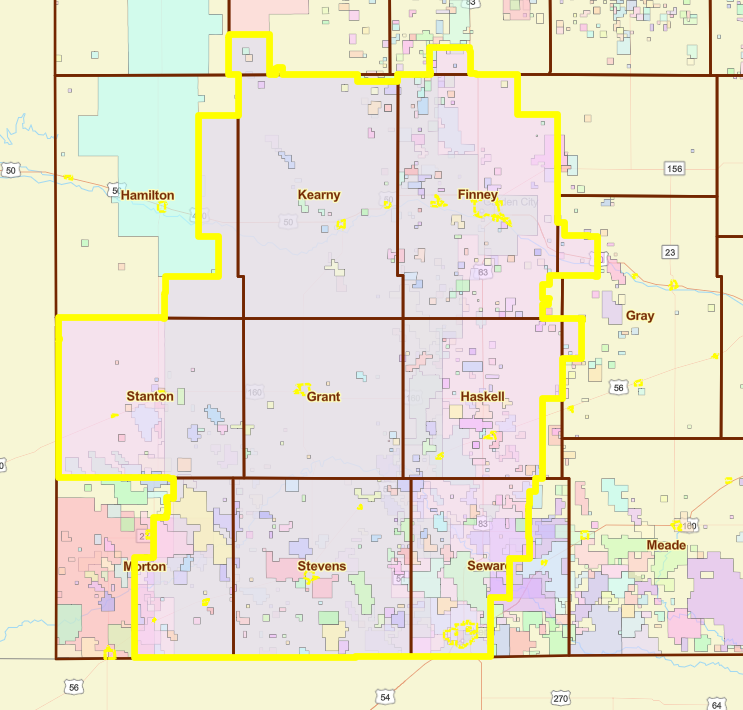In this episode we provide an overview of the Hugoton Basin / Gas Field located in western Kansas. Learn about the history, geology, operators, and risks related to owning minerals and royalties in this prolific natural gas play. Plus, we talk about the exciting opportunity around Helium royalties in the Hugoton Gas Field. In fact, we received a request from a listener to cover this Basin/Gas Play:
“For other basis to discuss, I’d love to hear you guys talk about the Hugoton basin between Kansas and Texas. I’ve been working hard in this area recently and I’d like to hear your perspectives. The basin includes a significant amount of helium production as well. In some of my leases, 0.5% of the total gas stream is helium, but it accounts for 25% of my royalty. Helium is a very valuable commodity. I’m currently working with the state of Kansas to change the operator / purchaser reporting to break out helium from natural gas so the state can track it in real time, as well as post the helium volumes produced in their website for royalty owners to reconcile their checks.”
This is the eighth episode in our series about the major producing oil and gas basins and plays in the US. Please let us know if you have any requests on a particular area that you would like us to cover. We covered the Permian Basin, DJ Basin, Uinta Basin, Powder River Basin, SCOOP/STACK/MERGE Plays , Haynesville Shale, and Williston Basin/Bakken Shale in previous episodes.
Be sure to also subscribe on Apple Podcasts via the link above (or wherever you get your podcasts) and please leave us an honest rating and review. We read every one of them and sincerely appreciate any feedback you have. Let us know if you have an area that you would like us to feature in a future episode; just send an email to feedback@mineralrightspodcast.com.
Let’s dive in to our overview of the Hugoton Gas Field.
Location
The Hugoton Basin is located in Kansas and is a major oil and gas producing area. The name is derived from the town of Hugoton, Kansas near where the Hugoton Field was first discovered. It spans from West-Central Kansas down through the panhandle of Oklahoma and Texas. The primary counties in Kansas where the Hugoton Gas Field is located are: Kearny, Finney, Stanton, Grant, Haskell, Morton, Stevens, and Seward counties.
History
According to Wikipedia: “Natural gas in the Hugoton area was first discovered in 1922 in the Boles #1 well, in Seward County, two miles west of Liberal. The well was drilled in 1919 to a depth of 2,919 feet by the Defenders Petroleum and Traders Oil and Gas Company, but was shut in for three years because it did not find oil. In 1922 the well was completed as a gas well, but there was little demand for natural gas in the area and it was years before another gas well was drilled in the field.
In 1927, gas was discovered at the Independent Oil and Gas Company’s Crawford No. 1,about 2,600 feet below the surface southwest of Hugoton, Kansas, in Stevens County. This is now considered the center of the Hugoton Field. By the end of 1928, five wells had been drilled in the field and the first pipeline was transporting gas to local markets. In 1929, Argus Pipe Line Company started construction of a pipeline to furnish gas to Dodge City, Kansas. Construction of major pipelines in the 1930s encouraged further drilling in the area. In 1977, gas was discovered by Brown and Woolsey in the M. MAUNE, Well 1. All of these wells produced from the Chase Formation.”
Through July of this year the Hugoton Gas Field has produced over 19 tcf of gas and more than 4 million barrels of oil. That said, this is primarily a natural gas producing area with minimal oil production of only 17,835 bbls of oil but more than 72 bcf of gas in 2021.
The majority of the activity in the Hugoton Gas Field occurred in the 1990’s and specifically from 1990 to around 1998. And while production has been on the decline since then it is still significant as previously mentioned.
One of the reasons that the Hugoton Gas Field is significant is due to the high concentrations of helium.
Geology and Major Oil and Gas Formations
The primary producing formation is the chase group which is comprised of the Herington through Ft. Riley Limestones.
According to the Kansas Geological Survey:
“The overall thickness of the Chase group is relatively constant over most of the field but a slight thinning occurs to the west and north going out of the Hugoton Embayment. Individual formations tend to lose their identity to the north and west as shale and siltstone increase. The total thickness of the reservoir rocks (Herington through Ft. Riley) including shale members is over 200 feet. Dolomite, dolomitic limestone and limestone comprise the pay sections.”
As compared to the unconventional or shale basins and plays that we have covered previously, the Hugoton Gas Field contains a stratigraphic trap which allowed gas to accumulate within the chase group. This is what the Kansas Geological Survey says about this stratigraphic type trap:
“Stratigraphic type trap – the result of a facies change causing an up dip pinchout of porosity. Porous limestones and dolomites of the Permian Chase group grade westward and up dip into relatively impermeable red shale and siltstone. The overlying Wellington shale formed the seal and basinward tilting positioned the low porosity clastic facies up dip from the carbonates.”
Part of the reason for the high gas productivity and steady reservoir pressures is due to the fact that the field benefits from a water drive to help push the gas into the wellbore. That said water production is considered a minor problem.
The natural gas in the Hugoton field contains high concentrations of helium from 0.3% to 1.9% and because of this it contains the largest helium reserves in the U.S.
The natural gas produced form the chase group is relatively dry (meaning low percentage of natural gas liquids) and contains around 72% methane, 6.5% ethane, 3% propane, and 1% butane. The typical BTU factor of produced gas is 1008 btu/scf which is pretty close to the energy content in the natural gas you use to heat your home or to cook with.
Hugoton Gas Area–Oil and Gas Production
Major Producers
The top 10 operating companies ranked by annual natural gas production are:
Current activity levels
According to the Hays post, the number of intent to drill notices across Kansas was over 1,611 as of December 6, 2022 which is up by more than 451 from last year.
The rig count across the state was a lot higher than you might think when looking at the Baker Hughes Rig Count which doesn’t mention Kansas at all. This is because the type of rig being measured is different with these more along the lines of a water well drilling rig vs. a large horizontal rotary drilling rig which is what Baker Hughes keeps track of.
Independent Oil & Gas Service reported as of December 6th, 2022 that there were 21 active drilling rigs east of Wichita and 29 in Western Kansas which is where the Hugoton Gas Field is located.
Political Risk
As mentioned previously, helium is becoming more prevalent in its requirement for medical and industrial applications. The hugotion is one of the major sources for domestic helium as demand increases we could anticipate that production would also increase. Kansas has a long history of being pro oil and gas.
Geologic Risk
Conventional play vs resource play such as the Permian basin. More challenging to find a geologic location. Conventional plays don’t produce as much, however the production is more stable and follows a predictable decline curve.
Infrastructure
Plenty of oil takeaway capacity in Kansas with the Keystone Pipeline running through the state. Interestingly, there was a 14,000 barrel oil spill in Kansas just last week on the Keystone Pipeline. This is actually one of the largest crude oil spills in the U.s. in nearly a decade according to Reuters. As of the time of this recording I believe the 622,000 barrel per day pipeline was shutdown. Keystone pipeline shut after 14,000-barrel oil spill in Kansas | Reuters
Of course, this oil pipeline infrastructure is great should there ever be a major oil discovery in Kansas but the bigger concern for the Hugoton Gas Play is the natural gas takeaway capacity which doesn’t appear to be an issue. With production down from the peak seen in the 1990’s there is room to grow.
Outlook
One of the primary drivers for increased activity in the Hugoton Basin is the demand for Helium:
“Global helium market is currently witnessing increased demand as new applications are developed for the gas. This increased demand will continue to support prices and growth through 2028. By then, the market is estimated to reach $6.59 billion. One of the main drivers behind this demand is the growing medical and industrial sectors, which are both interested in using helium as a fuel because of its high energy content and negligible environmental impact. These groups will continue to be key drivers of the market through 2028.”
A decade-long price slump has left inventories depleted, and producers are still trying to find an equilibrium price for helium that will cover production costs without driving up supplies. In 2021, the average helium spot price was $64,900 MT, down from a high of $66,200 MT in 2016.
Resources Mentioned in This Episode
- Hugoton Gas Field General Information
- Hugoton Gas Area–Oil and Gas Production
- MRP 155: Helium Royalties At All Time High?
- Helium Market to Touch Valuation of $6.59 Billion By 2028 | Price Volatility and Shortage to Remain a Key Challenges
- News From the Oil Patch: US production up; Kan. production down
Thanks for Listening!
To share your thoughts:
- Leave a comment or question below (we read each one and your question may be featured in a future episode)!
- Ask a question or leave us feedback via email or voicemail: (720) 580-2088.
To help out the show:
- Subscribe and leave a review on Apple Podcasts or wherever you get your podcasts – we read each one and greatly appreciate it. Plus, you can get a shout out on a future episode!
Thanks again – until next time!




